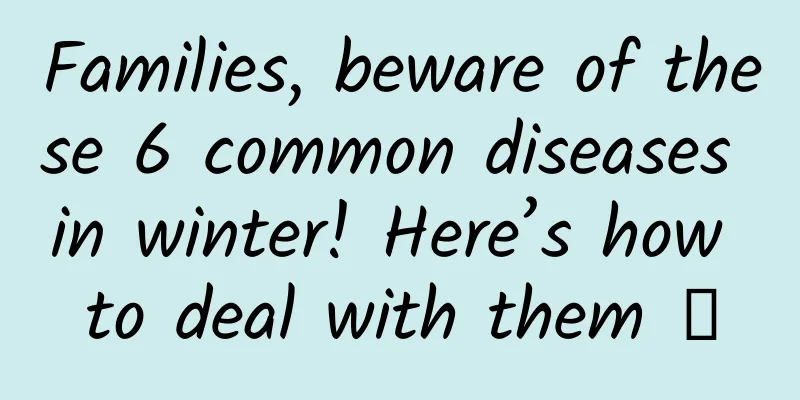Families, beware of these 6 common diseases in winter! Here’s how to deal with them →

|
The harsh winter is a test for every organ in the body. Due to the cold and dry weather, the large temperature difference between day and night, and the significant temperature difference between indoors and outdoors, many chronic diseases are prone to occur in winter. If not taken seriously, they may even endanger life. What are the diseases that are prone to occur in winter? What should we pay attention to? Cardiovascular and cerebrovascular diseases High incidence reasons: Due to the low temperature in winter, blood vessels, especially coronary arteries, are prone to contraction and spasm, resulting in increased vascular resistance and blood pressure, increased cardiac load, and high cerebral vascular perfusion, which can easily lead to cerebrovascular diseases. After stimulation by cold air, small clots are more likely to appear in the blood, and the small clots in the cardiovascular and cerebral blood vessels increase rapidly, which can cause coronary heart disease, angina attacks, myocardial infarction and stroke. In addition, the human body will shiver involuntarily due to the cold, and the body will produce heat to resist the cold, so the heart consumes more oxygen, which is also easy to cause cardiovascular diseases. If you don't pay attention to keeping warm and protecting yourself, it is easy to cause myocardial infarction, cerebral infarction, sudden death and other accidents. Susceptible groups: the elderly, people with cardiovascular and cerebrovascular diseases, and people with diabetes. Main symptoms: fatigue, dizziness, headache, vertigo for several days or suddenly, limb movement disorders, chest discomfort, palpitations, angina pectoris, shortness of breath. Some patients also have nausea and vomiting. In severe cases, patients may fall and become unconscious. Coping strategies: 1. When the temperature drops suddenly, put on more clothes in time; pay attention to keeping warm when sleeping at night. 2. Keep your emotions stable and avoid mental stress and emotional excitement. 3. Pay attention to the combination of work and rest to avoid excessive fatigue. 4. Eat more foods rich in fiber to keep bowel movements smooth and prevent constipation. 5. Have regular physical examinations or checkups. Patients with cardiovascular and cerebrovascular diseases should take medications on time and should not reduce or stop medications suddenly. 6. Elderly people should carry nitroglycerin, quick-acting heart-saving pills and other medicines with them so that they can take them as soon as possible when the disease occurs. Once the disease occurs, call 120 as soon as possible and go to the hospital for treatment as soon as possible. Respiratory diseases Common respiratory diseases include influenza, common cold, acute tracheobronchitis, acute exacerbation of chronic bronchitis, etc. Image source: pixabay Reasons for high incidence: Winter is the season when common colds and flu are most prevalent. Under the stimulation of cold air, the capillaries in the upper respiratory tract mucosa contract, blood supply decreases, immunoglobulin secretion also decreases accordingly, and the protective ability decreases, making it easy for bacteria and viruses to take advantage of the situation. The concentration of fine particulate toxic substances in air pollution is highest in winter. These toxic substances and dry and cold air will irritate the respiratory tract, causing symptoms such as coughing, sputum, and difficulty breathing, and aggravating the symptoms of chronic bronchitis, chronic obstructive pulmonary disease and other diseases. Susceptible groups: the elderly and infirm, children, people with chronic diseases and those with weakened immunity. 1 influenza Influenza, also known as influenza, is an acute respiratory infectious disease caused by influenza virus. The virus is spread from person to person through droplets produced by sneezing, coughing and talking. Influenza has a wide impact, is highly harmful, spreads rapidly, and may also cause complications such as pneumonia, myocarditis, meningitis, and even death in severe cases. Children's respiratory and immune systems are not yet fully developed, and their immune protection is weak, making them more susceptible to infection. This winter, many children were infected with influenza A virus, influenza B virus, respiratory syncytial virus, and adenovirus, and many children's hospitals were overcrowded. Main manifestations: acute onset, high fever, chills, headache, muscle and joint pain, general fatigue, nasal congestion, sore throat, dry cough, and a small number of patients have gastrointestinal symptoms such as nausea, vomiting, and diarrhea. 2 Common cold Main symptoms: runny nose, nasal congestion, sneezing, itchy throat, sore throat, cough, mild fever, headache. Common cold rarely causes high fever and body aches, has a short onset period, and is easy to cure. However, if not treated properly, it can easily develop into acute tracheobronchitis. Coping strategies: 1. Keep warm and add or remove clothes as the temperature changes. 2. Increase outdoor activities and improve physical fitness. 3. Eat a balanced diet and ensure nutrition. 4. Ensure adequate rest and sleep. 5. Open windows regularly to ventilate and keep indoor air circulating. 6. Develop a good habit of washing hands frequently. 7. During the peak influenza season, avoid going to crowded, enclosed public places, and wear a mask when entering and leaving public places. 8. Get the flu vaccine in advance, and key groups such as the elderly and children should be vaccinated in a timely manner. 9. After the symptoms of respiratory infection appear, the patient should be closely monitored and seek medical attention if necessary. Elderly people fall and suffer fractures and multiple complications Common causes: Falling is the leading cause of accidental death for people over 65 years old. In winter, if it snows or freezes, the road is slippery, and thick clothing blocks the view of the road below. Elderly people are more likely to fall and suffer fractures in winter. Once an elderly person suffers a fracture, it is easy to aggravate existing medical system diseases and cause complications such as urinary tract infections, bedsores, and pneumonia. Image source: pixabay Susceptible groups: People over 65 years old. Main symptoms: fractures after falling, pain, inability to get up, or feeling uncomfortable after getting up. Coping strategies: 1. Install anti-slip handrails on the walls of toilets, squat toilets, kitchens, stairs, corridors, etc., install night lights, apply anti-slip wax on the floors, etc. 2. It is best to wear non-slip shoes. 3. Try not to go out when it rains or snows. It is recommended to put a piece of paper with your family's contact information in your pocket before going out, so that you or passers-by or medical staff can contact your family in time in case of an accident. 4. Don’t rush to get up after falling. Feel your physical condition first: If you feel unwell, seek help from passers-by or family members in time, call 120 as soon as possible, and wait for medical staff to come to rescue; if you can stand up, you can slowly move to a nearby safe place, rest and observe your physical condition, and continue to observe it in the next few days. If you feel something is wrong, it is best to go to the hospital for a check-up. Hypothermia syndrome High incidence reasons: In the cold winter, when staying outdoors for a long time in low temperatures, the heat generated by the human body is far less than the heat lost, which will eventually cause the body temperature to drop and become low. Hypothermia can affect the brain, causing people to be unconscious or have difficulty in moving. This makes people unable to realize that their bodies are in danger and thus unable to save themselves. Image source: pixabay Susceptible groups: People over 60 years old. Main symptoms: Fear of cold, cold limbs, body temperature drops below 35 degrees Celsius. Coping strategies: 1. Add or remove clothes according to the temperature and keep warm. 2. Go outdoors less in cold weather. 3. Observe how your body responds to cold weather and monitor your body temperature regularly. 4. Participate in activities or exercises within your ability to increase blood circulation and promote body heat. 5. Pay attention to your diet, maintain a balanced nutrition, eat hot meals and dishes, and drink warm water. frostbite Causes of high incidence: Frostbite, also known as non-freezing cold injury, is a common skin disease in winter. When the skin is in a cold (0-10℃), sudden temperature changes or humid environment, it will cause strong contraction of local arterioles, paralysis of arterial blood vessels, and then expansion, resulting in obstruction of venous return and congestion, causing poor local blood circulation and inducing local skin inflammation. Susceptible groups: children, women, people with anemia, obesity, diabetes, sweaty hands and feet, and those who work outdoors in low temperatures for a long time. Main manifestations: It often occurs on the fingers, back of hands, toes, heels, nose tip, auricle, earlobe and cheeks. The local skin will become red, swollen, itchy and painful. In severe cases, blisters and ulcers may occur. Because the contraction and relaxation functions of blood vessels are impaired in the location where frostbite occurred, even if the frostbite is cured this time, it is very easy to relapse at the slightest disturbance. Coping strategies: 1. Prevent freezing and moisture, keep warm, and wear gloves, scarves, hats and masks. 2. Strengthen physical exercise to promote blood circulation and body heat. 3. After the limbs are frozen, it is not advisable to soak them in hot water or warm them by the fire immediately. 4. People with underlying diseases such as diabetes and systemic lupus erythematosus should receive active treatment. 5. For those who suffer from recurrent frostbite, in addition to drug treatment, sub-erythema doses of ultraviolet or infrared rays can be used to irradiate the local skin before winter to play a certain preventive role. This article is a work of Science Popularization China-Starry Sky Project Produced by: Science Popularization Department of China Association for Science and Technology Producer|China Science and Technology Press Co., Ltd., Beijing Zhongke Xinghe Culture Media Co., Ltd. Author: Zeng Xinyue, popular science creator Reviewer: Tang Qin, Director and Researcher of the Science Popularization Department of the Chinese Medical Association |
>>: Things to know about Mycoplasma pneumonia!
Recommend
Poor egg development
When the egg does not develop well, it may be due...
Can the lactic acid bacteria in fermented yogurt be eaten directly? Why does my stomach hurt after drinking homemade yogurt?
Yogurt is made from fermented milk, and lactic ac...
What causes yellow watery vaginal discharge?
Leucorrhea is an indispensable topic of concern f...
Dietary taboos during breastfeeding
Here are some dietary taboos during breastfeeding...
Can I get pregnant if I have uterine fibroids?
Uterine fibroids are a gynecological disease that...
Can I do sit-ups during my period?
Girls start to menstruate when they enter puberty...
What is the reason for a small amount of blood in the vagina?
Leucorrhea with blood is medically called bloody ...
What clothes should be worn under a woolen coat? How to wear a woolen coat to look good and keep warm?
Woolen coats are one of the must-have items in th...
How many days will abdominal pain occur in ectopic pregnancy
When it comes to ectopic pregnancy, I believe eve...
What are the recipes for women to nourish their brains?
The issue of health preservation is the most disc...
Treatment for gray hair after childbirth
Many mothers are very distressed about the appear...
Is it normal for pregnant women to have yellow vaginal discharge?
Pregnancy is an important stage in a woman's ...
How to lose weight after childbirth
After giving birth, the mother found that she had...
A woman with a mole on the right chin
The facial features of the jaw area can reflect a...
What to do if breasts swell after giving birth
Most women will have breast swelling after giving...









